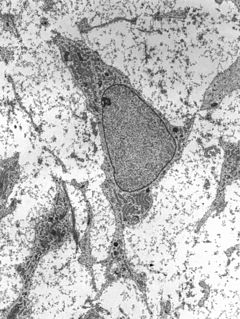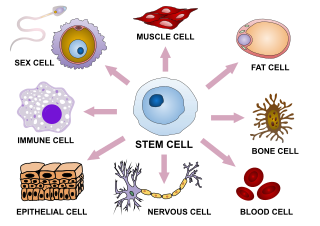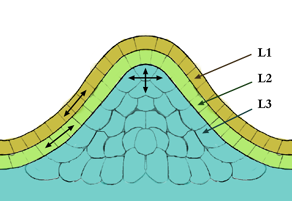This article has multiple issues. Please help improve it or discuss these issues on the talk page . (Learn how and when to remove these template messages)
|

This article has multiple issues. Please help improve it or discuss these issues on the talk page . (Learn how and when to remove these template messages)
|

Plant stem cells are innately undifferentiated cells located in the meristems of plants. [1] Plant stem cells serve as the origin of plant vitality, as they maintain themselves while providing a steady supply of precursor cells to form differentiated tissues and organs in plants. [2] [ failed verification ] Two distinct areas of stem cells are recognised: the apical meristem and the lateral meristem.
Plant stem cells are characterized by two distinctive properties, which are: the ability to create all differentiated cell types and the ability to self-renew such that the number of stem cells is maintained. [3] Plant stem cells never undergo aging process but immortally give rise to new specialized and unspecialized cells, and they have the potential to grow into any organ, tissue, or cell in the body. [2] [ failed verification ] Thus they are totipotent cells equipped with regenerative powers that facilitate plant growth and production of new organs throughout lifetime. [1] [ failed verification ]
Unlike animals, plants are immobile. As plants cannot escape from danger by taking motion, they need a special mechanism to withstand various and sometimes unforeseen environmental stress. Here, what empowers them to withstand harsh external influence and preserve life is stem cells. In fact, plants comprise the oldest and the largest living organisms on earth, including Bristlecone Pines in California, U.S. (4,842 years old), and the Giant Sequoia in mountainous regions of California, U.S. (87 meters in height and 2,000 tons in weight). [4] This is possible because they have a modular body plan that enables them to survive substantial damage by initiating continuous and repetitive formation of new structures and organs such as leaves and flowers. [1]
Plant stem cells are also characterized by their location in specialized structures called meristematic tissues, which are located in root apical meristem (RAM), shoot apical meristem (SAM), and vascular system ((pro)cambium or vascular meristem.) [5]
Traditionally, plant stem cells were thought to only exist in SAM and RAM and studies were conducted based on this assumption. However, recent studies have indicated that (pro)cambium also serves as a niche for plant stem cells: "Procambium cells fulfill the criteria for being stem cells since they have the capacity for long-term self renewal and being able to differentiate into one or more specialized cell types." [6] [ failed verification ]
Cambium is a type of meristem with thin walls which minutely exist in small populations within a plant. Due to this structural characteristic, once physical force is applied to it, it is easily damaged in the very process of isolation, losing its stem cell characteristics. Despite 160 years of biological effort to isolate and retrieve plant stem cells, none succeeded in the isolation due to the distinct structural characteristics of plant stem cell: "[t]he cambium consists of a few layers of narrow elongated, thin-walled cells, easily damaged during sampling." This highly vulnerable feature has made studies on cambial structure and ultrastructure difficult to achieve with conventional methods. Thus failure to isolate plant stem cells from meristematic tissues prompted scientists to administer plant cell culture by using callus (dedifferentiated cells) as an alternative to plant stem cells.
Callus, or dedifferentiated cells, are somatic cells that undergo dedifferentiation to give rise to totipotent embryogenic cells, which temporarily gains the ability to proliferate and/or regenerate an embryo. Since embryogenic cells were considered totipotent cells based on their ability to regenerate or develop into an embryo under given conditions, dedifferentiated cells were generally regarded as stem cells of plant: "…we propose to extend the concept of stem cells to include embryogenic stem cells that arise from plant somatic cells. We examine the cellular, physiological and molecular similarities and differences between plant meristematic stem cells and embryogenic stem cells originating directly from single somatic cells."
Despite that callus exhibits a number of stem cell-like properties for a temporary period and that it has been cultured for useful plant compounds as an alternative source of plant stem cell, callus and plant stem cell are fundamentally different from each other. Callus is similar to plant stem cell in its ability to differentiate, but the two are different in their origin. While plant stem cell exists in the meristematic tissues of plant, callus is obtained as a temporary response to cure wounds in somatic cell.
Moreover, callus undergoes dedifferentiation as differentiated cells acquire ability to differentiate; but genetic variation is inevitable in the process because the cells consist of somatic undifferentiated cells from an adult subject plant. Unlike true stem cells, callus is heterogeneous. Due to this reason, continuous and stable cell division of callus is difficult. Hence a plant stem cell originated from cambium is an immortal cell while that from callus is a temporarily dediffertiated cell obtained from stimulating the somatic cell.
Furthermore, the ability to differentiate and proliferate is different that differences between plant stem cell and callus are prevalent in culture and research. Only plant stem cells embedded in meristems can divide and give rise to cells that differentiate while giving rise to new stem cells. These immortal cells divide infinitely.
Plant cells are cultured to acquire plant useful compounds. However cell cultures are often hindered by various factors especially if cell culture continues long-term. However, strong vitality and structural characteristics of plant stem cell overcome previous drawbacks to plant cell culture. Thus plant stem cell culture is the most ideal and productive method of cell culture and phytochemical production as cells are successfully mass cultured while maintaining quality.
Numerous medicines, perfumes, pigments, antimicrobials, and insecticides are derived from plant natural products. Cultured Cambial Meristematic Cells (CMC) may provide a cost-effective, environmentally friendly, and sustainable source of important natural products, including paclitaxel. Unlike plant cultivation, this approach is not subject to the unpredictability caused by variation in climatic conditions or political instability in certain parts of the world. Also, CMCs from reference specifies may also provide an important biological tool to explore plant stem cell function.
In 2010, researchers from the Plant Stem Cell Institute (formerly Unhwa Institute of Science and Technology) presented their data to the world via Nature Biotechnology. Their research demonstrated the world's first cambial meristematic cell isolation. Due to the valuable and beneficial compounds for human health (i.e. paclitaxel) which are secreted by the CMC's, this technology is considered a serious breakthrough in plant biotechnology. [7] [ non-primary source needed ]
Developmental biology is the study of the process by which animals and plants grow and develop. Developmental biology also encompasses the biology of regeneration, asexual reproduction, metamorphosis, and the growth and differentiation of stem cells in the adult organism.

In multicellular organisms, stem cells are undifferentiated or partially differentiated cells that can differentiate into various types of cells and proliferate indefinitely to produce more of the same stem cell. They are the earliest type of cell in a cell lineage. They are found in both embryonic and adult organisms, but they have slightly different properties in each. They are usually distinguished from progenitor cells, which cannot divide indefinitely, and precursor or blast cells, which are usually committed to differentiating into one cell type.

In biology, tissue is a cellular organizational level between cells and a complete organ. A tissue is an ensemble of similar cells and their extracellular matrix from the same origin that together carry out a specific function. Organs are then formed by the functional grouping together of multiple tissues.

Cellular differentiation is the process in which a cell changes from one cell type to another. Usually, the cell changes to a more specialized type. Differentiation occurs numerous times during the development of a multicellular organism as it changes from a simple zygote to a complex system of tissues and cell types. Differentiation continues in adulthood as adult stem cells divide and create fully differentiated daughter cells during tissue repair and during normal cell turnover. Some differentiation occurs in response to antigen exposure. Differentiation dramatically changes a cell's size, shape, membrane potential, metabolic activity, and responsiveness to signals. These changes are largely due to highly controlled modifications in gene expression and are the study of epigenetics. With a few exceptions, cellular differentiation almost never involves a change in the DNA sequence itself. Although metabolic composition does get altered quite dramatically where stem cells are characterized by abundant metabolites with highly unsaturated structures whose levels decrease upon differentiation. Thus, different cells can have very different physical characteristics despite having the same genome.

The vascular cambium is the main growth tissue in the stems and roots of many plants, specifically in dicots such as buttercups and oak trees, gymnosperms such as pine trees, as well as in certain other vascular plants. It produces secondary xylem inwards, towards the pith, and secondary phloem outwards, towards the bark.

The meristem is a type of tissue found in plants. It consists of undifferentiated cells capable of cell division. Cells in the meristem can develop into all the other tissues and organs that occur in plants. These cells continue to divide until a time when they get differentiated and then lose the ability to divide.

Vegetative reproduction is any form of asexual reproduction occurring in plants in which a new plant grows from a fragment or cutting of the parent plant or a specialized reproductive structure.

Plant callus is a growing mass of unorganized plant parenchyma cells. In living plants, callus cells are those cells that cover a plant wound. In biological research and biotechnology callus formation is induced from plant tissue samples (explants) after surface sterilization and plating onto tissue culture medium in vitro. The culture medium is supplemented with plant growth regulators, such as auxin, cytokinin, and gibberellin, to initiate callus formation or somatic embryogenesis. Callus initiation has been described for all major groups of land plants.
Organogenesis is the phase of embryonic development that starts at the end of gastrulation and continues until birth. During organogenesis, the three germ layers formed from gastrulation form the internal organs of the organism.

Embryoid bodies (EBs) are three-dimensional aggregates of pluripotent stem cells.
Plant embryogenesis is a process that occurs after the fertilization of an ovule to produce a fully developed plant embryo. This is a pertinent stage in the plant life cycle that is followed by dormancy and germination. The zygote produced after fertilization must undergo various cellular divisions and differentiations to become a mature embryo. An end stage embryo has five major components including the shoot apical meristem, hypocotyl, root meristem, root cap, and cotyledons. Unlike animal embryogenesis, plant embryogenesis results in an immature form of the plant, lacking most structures like leaves, stems, and reproductive structures. However, both plants and animals pass through a phylotypic stage that evolved independently and that causes a developmental constraint limiting morphological diversification.

A stem cell line is a group of stem cells that is cultured in vitro and can be propagated indefinitely. Stem cell lines are derived from either animal or human tissues and come from one of three sources: embryonic stem cells, adult stem cells, or induced stem cells. They are commonly used in research and regenerative medicine.
Important structures in plant development are buds, shoots, roots, leaves, and flowers; plants produce these tissues and structures throughout their life from meristems located at the tips of organs, or between mature tissues. Thus, a living plant always has embryonic tissues. By contrast, an animal embryo will very early produce all of the body parts that it will ever have in its life. When the animal is born, it has all its body parts and from that point will only grow larger and more mature. However, both plants and animals pass through a phylotypic stage that evolved independently and that causes a developmental constraint limiting morphological diversification.
Plant tissue culture is a collection of techniques used to maintain or grow plant cells, tissues or organs under sterile conditions on a nutrient culture medium of known composition. It is widely used to produce clones of a plant in a method known as micropropagation. Different techniques in plant tissue culture may offer certain advantages over traditional methods of propagation, including:

Cell potential, based on the 2007 works of Hans R. Schöler "The Potential of Stem Cells: An Inventory", is a cell's ability to differentiate into other cell types. The more cell types a cell can differentiate into, the greater its potency. Potency is also described as the gene activation potential within a cell, which like a continuum, begins with totipotency to designate a cell with the most differentiation potential, pluripotency, multipotency, oligopotency, and finally unipotency.

Somatic embryogenesis is an artificial process in which a plant or embryo is derived from a single somatic cell. Somatic embryos are formed from plant cells that are not normally involved in the development of embryos, i.e. ordinary plant tissue. No endosperm or seed coat is formed around a somatic embryo.
Induced stem cells (iSC) are stem cells derived from somatic, reproductive, pluripotent or other cell types by deliberate epigenetic reprogramming. They are classified as either totipotent (iTC), pluripotent (iPSC) or progenitor or unipotent – (iUSC) according to their developmental potential and degree of dedifferentiation. Progenitors are obtained by so-called direct reprogramming or directed differentiation and are also called induced somatic stem cells.
Epimorphosis is defined as the regeneration of a specific part of an organism in a way that involves extensive cell proliferation of somatic stem cells, dedifferentiation, and reformation, as well as blastema formation. Epimorphosis can be considered a simple model for development, though it only occurs in tissues surrounding the site of injury rather than occurring system-wide. Epimorphosis restores the anatomy of the organism and the original polarity that existed before the destruction of the tissue and/or a structure of the organism. Epimorphosis regeneration can be observed in both vertebrates and invertebrates such as the common examples: salamanders, annelidas, and planarians.
CLE peptides are a group of peptides found in plants that are involved with cell signaling. Production is controlled by the CLE genes. Upon binding to a CLE peptide receptor in another cell, a chain reaction of events occurs, which can lead to various physiological and developmental processes. This signaling pathway is conserved in diverse land plants.
Dedifferentiation is a transient process by which cells become less specialized and return to an earlier cell state within the same lineage. This suggests an increase in a cell potency, meaning that after dedifferentiation, cells may possess an ability to redifferentiate into more cell types than it did before. This is in contrast to differentiation, where differences in gene expression, morphology, or physiology arise in a cell, making its function increasingly specialized.